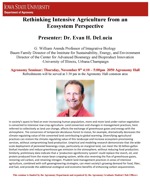Rethinking Intensive Agriculture from an Ecosystem Perspective
| Date/Time: | Thursday, 08 Nov 2018 from 4:00 pm to 5:00 pm |
|---|---|
| Location: | 2050 Agronomy Hall |
| Phone: | 515-294-1306 |
| Channel: | Agronomy Department |
| Actions: | Download iCal/vCal | Email Reminder |
In society's quest to feed an ever-increasing human population, more and more land under native vegetation is converted to intensive row-crop agriculture. Land conversion and changes in management practices, here referred to collectively as land use change, affects the exchange of greenhouse gases and energy with the atmosphere. The conversion of temperate deciduous forest to maize, for example, dramatically decreases the climate regulating value of the converted land contributing to global warming. Diversifying agricultural practices can restore the climate regulating value of this landscape and increase ecosystem provisioning services, without compromising food production. Empirical and modeling research demonstrate that the widescale deployment of perennial bioenergy crops, particularly on marginal land, can meet the 32-billion-gallon biofuel mandate and reduce greenhouse gas emission to the atmosphere, without reducing food production. Similarly, preliminary data indicate that a 'production agroforestry system' could replace the starch, oil, and protein produced from the maize-bean cropping system, while also reversing the flux of greenhouse gases, restoring soil carbon, and retaining nitrogen. Prudent land management practices in areas of intensive agriculture, combined with soft geoengineering strategies, can meet society's growing demand for food, fiber, and fuel, and provide the additional ecological and economic benefits of enhancing carbon sequestration.
